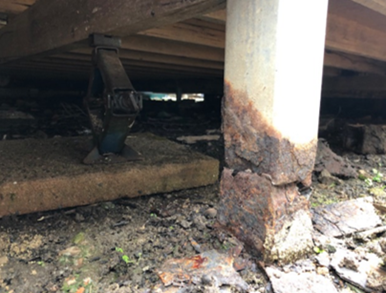On this page
Requirements at the Construction Certificate stage
Requirements for Hot Dip Galvanised steel members
Requirements for duplex and painted protective coatings
Key information
- Certifiers must meet corrosion protection requirements of Clause 6.3.9 of BCA Volume Two 2022.
- Posts must be designed, manufactured and installed in accordance with the Building Code of Australia (BCA) and relevant Australian Standards.
- There are significant impacts when corrosion protection of steel posts of buildings with suspended flooring systems is inadequate
Introduction
Steel posts are a popular alternative to traditional concrete footings, providing cost-effective, and environmentally friendly options for builders.
However, a significant number of Class 1a buildings within coastal areas of Eastern Australia, have been constructed on steel posts without due consideration of the corrosivity of the location resulting in inadequate corrosion protection.
Impacts of inadequate corrosion protection of steel posts of buildings with suspended flooring systems include:
- Early and costly re-stumping
- Rectification of cracked floor and wall tiles to bathrooms
- Rectification of damage to waterproof membranes in wet areas
- Re-fitting doors throughout the house including internal and external doors
- Re-painting the house where cracks appear on the inside and outside the house
- Replacing or repairing hot- and cold-water connections, including stormwater, sewerage pipes and electrical connections
To help reduce these negative impacts and safety issues, certifiers must meet corrosion protection requirements of Clause 6.3.9 of BCA Volume Two 2022. These requirements differ based on the stage and/or type of construction.

Example of a steel post showing signs of corrosion after being installed 6 years earlier with inadequate corrosion protection.
To help reduce these negative impacts and safety issues, certifiers must meet corrosion protection requirements of Clause 6.3.9 of BCA Volume Two 2022. These requirements differ based on the stage and/or type of construction.
Requirements at the Construction Certificate stage
Determine the corrosivity category of the location of the building
Based on the building location, certifiers must determine the corrosivity category as either low, medium, high, or very high. In the table below, a figure has been included below for reference.
For further information on corrosivity environments, refer to Section 3 of AS 4312:2019 Atmospheric corrosivity zones in Australia.

Ensure architects and engineers designs specify suitable corrosion protection of the structural posts
The corrosion protection methods for the posts should be developed based on the corrosivity environment that has been determined.
For Hot Dip Galvanised steel members
The table below shows which readily available materials meet the requirements of Table 6.3.9a. If no certificate is available, then measure the HDG coating thickness. HDG coatings of all types are relatively straightforward to assess via the use of a non-destructive coating gauge, even if no certification from the supplier is available.
AS/NZS 4680 | Steel thickness | HDG coating | Environment and Deemed-to-Satisfy Housing Provisions Standard | |||
|---|---|---|---|---|---|---|
Low | Medium | High | Very High | |||
HDG 390 | >1.5 to ≤3.0 | 55 | Yes | Yes | 2D | 5D |
HDG 500 | >3.0 to ≤6.0 | 70 | Yes | Yes | Yes | 5D |
HDG 600 | >6.0 | 85 | Yes | Yes | Yes | 4D |
2D, 4D, and 5D refer to the painting systems under Table 7.1 of AS/NZS 2312.2:2014 Guide to the protection of structural steel against atmospheric corrosion by the use of protective coatings Part 2: Hot dip galvanizing.
BCA Volume Two 2022 was adopted on 1 May 2023, however, Clause 3.4.4.4 and Table 3.4.4.7 from BCA Volume Two 2019 (Amendment 1) may be used in place of Clause 6.3.9 and Tables 6.3.9a, 6.3.9b and 6.3.9c until 1 May 2024. As best practice, it is recommended that the Deemed-to-Satisfy provisions of BCA Volume Two 2022 be applied from 1 May 2023.
Requirements for duplex and painted protective coatings
Document the certificate from the painter, or document evidence from the builder of the materials used and ensure the overall coating thickness is measured. Paint systems must be in accordance with AS/NZS 2312.1 2014 Guide to the protection of structural steel against atmospheric corrosion by the use of protective coatings.
Requirements for Paint coatings
For paint (including duplex coatings), evidence of the surface preparation, paints used and the coating thickness for each type of paint will be required to assess conformance. Practically, a certificate from the paint applicator (if done in the factory), or evidence of the paint materials used by the builder (if done on-site) will be required.
Certifiers are encouraged to reference Section 12 of the Environmental Planning and Assessment (Development Certification and Fire Safety) Regulation 2021 when advising anyone involved in the design phase of what information the certifier considers necessary for the application to be considered.
Requirements Occupation Certificate stage
Ensure that the builder can demonstrate that the works have been constructed in accordance with the approved designs. This can be in the form of a statement from the builder with supporting evidence of the materials used.
Where the steel has been cut, the builder must confirm/verify the steel thickness and class of galvanization and demonstrate that all cut edges are repaired to the standard of the original corrosion protection. Look for rust or repairs to welded areas, cut ends, and other damage.
Obtain evidence that the repairs provide equivalent protection. This may include sighting the paint that was used or, for large areas of damage, measuring the coating thickness in the repaired area. If the damage has not been repaired, the product does not meet the requirements.
Certifiers are encouraged to reference Section 38 of the Environmental Planning and Assessment (Development Certification and Fire Safety) Regulation 2021 when advising anyone involved in the design phase of what information the certifier considers necessary for the application to be considered.